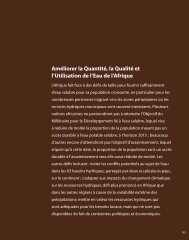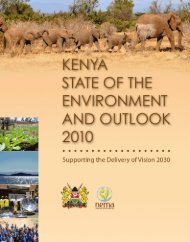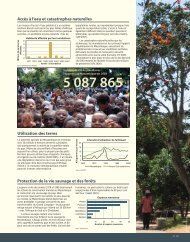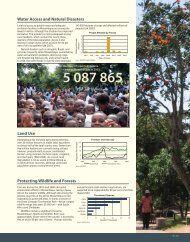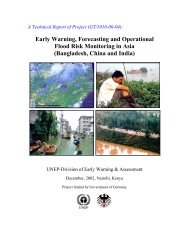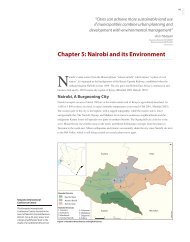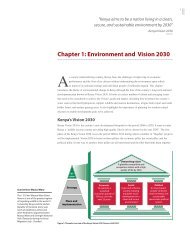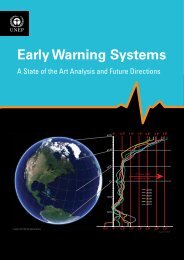Uganda Atlas of Our Changing Environment - GRID-Arendal
Uganda Atlas of Our Changing Environment - GRID-Arendal
Uganda Atlas of Our Changing Environment - GRID-Arendal
You also want an ePaper? Increase the reach of your titles
YUMPU automatically turns print PDFs into web optimized ePapers that Google loves.
<strong>Uganda</strong> experiences moderate temperatures<br />
throughout the year because <strong>of</strong> its location astride<br />
the equator and on a raised African plateau. The<br />
highest temperatures <strong>of</strong> over 30 0 C are experienced in the<br />
north and northeast <strong>of</strong> the country while temperatures<br />
as low as 4º C are experienced in the highlands <strong>of</strong> the<br />
southwest. Temperatures below 0ºC are registered on<br />
the high mountains <strong>of</strong> Rwenzori and Elgon. The Rwenzori<br />
mountains have a permanent ice cap whose size is<br />
currently reducing, presumably due to global warming<br />
(<strong>Uganda</strong> Met. Department, 2000; UBOS Statistical<br />
Abstracts, 2006).<br />
The high temperature records mean there is high<br />
potential for water evaporation, which in turn affects<br />
the water balance that influences the productivity <strong>of</strong><br />
the environment, including agriculture, the back bone<br />
<strong>of</strong> <strong>Uganda</strong>’s economy. Potential evaporation in excess <strong>of</strong><br />
rainfall leads to water deficit and vice versa.<br />
Temperature and rainfall are the most important<br />
parameters <strong>of</strong> climate in <strong>Uganda</strong>; temperatures are an<br />
important factor influencing rainfall and moisture, and in<br />
general play a major role in the determination <strong>of</strong> agroecological<br />
zones <strong>of</strong> the country.<br />
Most areas experience high potential for water<br />
evaporation in excess <strong>of</strong> rainfall. Therefore, sustainable<br />
management <strong>of</strong> water resources is needed. Water balance<br />
analysis in <strong>Uganda</strong> indicates that both areas <strong>of</strong> water<br />
surplus and water deficit occur. Water surplus occurs<br />
only around the high rainfall and low temperature areas<br />
<strong>of</strong> Mt. Rwenzori and Mt. Elgon. The northern shores <strong>of</strong><br />
Lake Victoria show a slight surplus or an almost even<br />
balance. Elsewhere, water deficits <strong>of</strong> varying degrees<br />
occur, generally increasing from south-west to north-east<br />
(Langlands 1974).<br />
Because <strong>of</strong> its location around the equator, <strong>Uganda</strong><br />
experiences equal hours <strong>of</strong> day light and night throughout<br />
the year, indicating that the country receives high solar<br />
radiation. However, periods <strong>of</strong> sunshine vary slightly<br />
during the day due to variations in cloud cover. The<br />
periods <strong>of</strong> high sunshine in the country are associated<br />
with lower relative humidity and a higher potential<br />
for evaporation. For example, the Lake Victoria basin<br />
experiences relatively low amounts <strong>of</strong> sunshine due to<br />
the usually cloudy skies while the south western highlands<br />
experience the lowest amounts <strong>of</strong> sunshine due to the<br />
unusually high cloud cover and prolonged light rains.<br />
4<br />
Climate<br />
Favourable climate in Manafwa District: Young men carry maize<br />
to a grinding mill at the nearby market<br />
NEMA 2008



